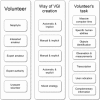A taxonomy of quality assessment methods for volunteered and crowdsourced geographic information
- PMID: 29937686
- PMCID: PMC5993263
- DOI: 10.1111/tgis.12329
A taxonomy of quality assessment methods for volunteered and crowdsourced geographic information
Abstract
The growing use of crowdsourced geographic information (CGI) has prompted the employment of several methods for assessing information quality, which are aimed at addressing concerns on the lack of quality of the information provided by non-experts. In this work, we propose a taxonomy of methods for assessing the quality of CGI when no reference data are available, which is likely to be the most common situation in practice. Our taxonomy includes 11 quality assessment methods that were identified by means of a systematic literature review. These methods are described in detail, including their main characteristics and limitations. This taxonomy not only provides a systematic and comprehensive account of the existing set of methods for CGI quality assessment, but also enables researchers working on the quality of CGI in various sources (e.g., social media, crowd sensing, collaborative mapping) to learn from each other, thus opening up avenues for future work that combines and extends existing methods into new application areas and domains.
Figures
References
-
- Albuquerque, J. P. , Herfort, B. , Brenning, A. , & Zipf, A. (2015). A geographic approach for combining social media and authoritative data towards identifying useful information for disaster management. International Journal of Geographical Information Science, 29(4), 667–689.
-
- Albuquerque, J. P. , Herfort, B. , & Eckle, M. (2016). The tasks of the crowd: A typology of tasks in geographic information crowdsourcing and a case study in humanitarian mapping. Remote Sensing, 8, 1–22.
-
- Albuquerque, J. P. , Herfort, B. , Eckle, M. , & Zipf, A. (2016). Crowdsourcing geographic information for disaster management and improving urban resilience: An overview of recent developments and lessons learned In Capineri C., Haklay M., Huang H., Antoniou V., Kettunen J., Ostermann F., & Purves R. (Eds.), European handbook of crowdsourced geographic information (pp. 309–321). London, UK: Ubiquity Press.
-
- Ali, A. L. , & Schmid, F. (2014). Data quality assurance for volunteered geographic information In Duckham M., Pebesma E., Stewart K., & Frank A. U. (Eds.), Geographic Information Science: Proceedings of the Eighth International Conference, GIScience 2014, Vienna, Austria, September 24–26, 2014 (pp. 126–141). Cham, Switzerland: Springer, Lecture Notes in Computer Science: Vol. 8728.
-
- Anhorn, J. , Herfort, B. , & Albuquerque, J. P. (2016). Crowdsourced validation and updating of dynamic features in OpenStreetMap: An analysis of shelter mapping after the 2015 Nepal earthquake In Proceedings of the 13th International Conference on Information Systems for Crisis Response and Management. Rio de Janeiro, Brazil: ISCRAM.
LinkOut - more resources
Full Text Sources
Other Literature Sources


